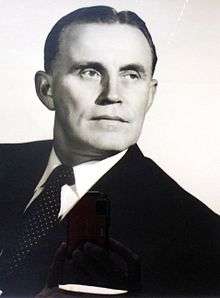George Lynn Cross
| George Lynn Cross Ph.D. | |
|---|---|
 George Lynn Cross | |
| Born |
May 12, 1905 Woonsocket, South Dakota |
| Died |
December 31, 1998 (aged 93) Norman, Oklahoma |
| Nationality | United States |
| Education | Doctorate in botany |
| Alma mater | University of Chicago |
| Occupation | University President |
| Years active | 1943-1968 |
| Employer | University of Oklahoma |
| Known for | Peaceful integration of the University of Oklahoma; building historically successful sports programs; speaking ability; popularity; length of tenure; |
| Notable work | Blacks in White Colleges, Presidents Can't Punt, |
| Predecessor | Joseph A. Brandt |
| Successor | John Herbert Hollomon, Jr. |
| Spouse(s) | Cleo S. Cross |
George Lynn Cross (May 12, 1905 – December 31, 1998) was a botanist, author, and the longest serving president of the University of Oklahoma[1] (1943 to 1968). After he was appointed president at the age of 38, Cross helped peacefully integrate the university; built and oversaw the most winning college football program of the 1950s; spearheaded the expansion of numerous academic programs and facilities; and then helped lead the university through the 1960s protest period.[2] After retiring as President, Cross wrote several books, the first of which, Blacks in White Colleges, described his personal experiences during the constitutional desegregation litigation that arose almost immediately after he became the university's young president.

Early life
Cross was born to a poor family in Woonsocket, South Dakota. Several of his half siblings had been afflicted with the debilitating condition Huntington's Corea and this, and its humble situation, cast his family into disrepute in the small community. Cross concluded it was not feasible to attend college. It was out of reach, and instead, he aimed at becoming a high school science teacher. But Cross' prowess in athletics, particularly football, attracted the attention of the football program at South Dakota State College. The program helped arrange a dishwashing job for Cross in the women's dormitory on campus, thus enabling Cross to finance his education there. On the first day of school, Cross met Cleo Sikkink of Waubay, South Dakota and the two began a romance. Her family, however, did not approve of the relationship because of Cross' poor prospects and his abject family background. Cleo's family forced her to leave school so as to separate her from Cross, which decision ultimately resulted in the couple's elopement a few months later. Cross then decided football was causing his body too much damage and that it held a limited future, and accordingly, he decided to concentrate on academics as a future livelihood. He studied botany and earned a master's degree in 1927.[2] He then attended the University of Chicago, where he earned his Ph.D. in Botany at the age of 23.
Cross as Teacher and Naturalist
Cross began his teaching career in South Dakota in the early 1930s. In the summer of 1934 at a biological station in Gothic, Colorado, Cross met and befriended one of the deans of ecology and conservation biology, Paul B. Sears, who was at that time teaching at the University of Oklahoma. Sears offered Cross a job and Cross, his wife Cleo and daughter Mary-Lynn moved to Norman, Oklahoma in 1934. Cross was offered a job as an associate professor. Before his death, Cross remarked that he largely took over Sears' teaching responsibilities, so that Sears could finish his watershed work, Deserts on the March, which is considered a classic of conservation biology.
Cross's academic specialty was botany, and George Lynn Cross Hall, which houses OU's department of botany and microbiology, was named in his honor and in tribute to this fact. While president, Cross prepared specimen slides that are still used in botany classes.
Presidency
Cross's popularity quickly grew amongst the faculty and staff, and when the university president at the time stepped down, he was named interim president while the board of regents searched for a new candidate. They eventually realized no better candidate existed and he remained president for 24 years.
Cross oversaw the college through a period of skyrocketing enrollment following World War II as thousands of veterans attended under the GI Bill.[1] He saw the construction of 37 new buildings and the donation by the U.S. Navy, in May 1946, of 1,400 acres (5.7 km2) to the campus.[1] Cross also oversaw the integration of the University of Oklahoma and the student protests of the 1960s.[1]
Cross was known for his public speaking ability and quick wit. His most famous quote came at a budget meeting with state legislators. After a long presentation and 45 minute justification of the OU budget,a legislator asked him why the university needed more money. A frustrated Cross replied "I would like to build a University of which the football team could be proud."[2]
David L. Boren, the university's current president, proclaimed that he wanted his time as president of the university to parallel that of Cross's.
References
- 1 2 3 4 Levy, David W., "University of Oklahoma," Encyclopedia of Oklahoma History and Culture Archived May 31, 2010, at the Wayback Machine. (accessed May 26, 2010).
- 1 2 3 Pittman, Kitty, Cross, George Lynn (1905-1998)," Encyclopedia of Oklahoma History and Culture Archived May 31, 2010, at the Wayback Machine. (accessed May 26, 2010).
External links
| Preceded by Joseph A. Brandt |
President of the University of Oklahoma 1943-1968 |
Succeeded by John Herbert Hollomon, Jr. |